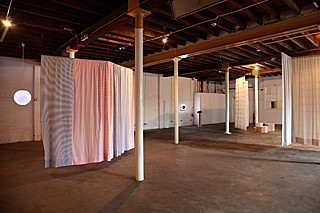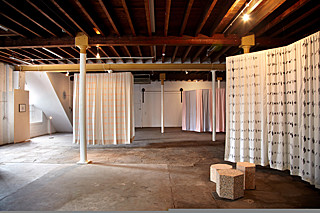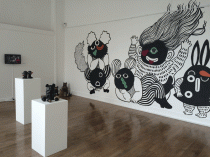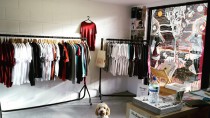On Shapes and Things
Richard Healy and Gemma Holt
Sierra Metro
The sixth chapter of E.H. Gombrich’s 1979 book The Sense of Order: A Study in the Psychology of Decorative Art provides a ‘unique language’ through which Richard Healy and Gemma Holt (in a new creative collaboration instigated and supported by the gallery) have considered the bonds and hierarchies that exist between pattern and object, whilst effecting to explore the divergent and often contentious relationship that exists between fine art and design practice.
Gombrich’s chapter begins with discussion of the kaleidoscope. Invented in 1816 as a scientific tool and named after the Ancient Greek for ‘beautiful form’, it quickly became appropriated as a toy, creating thrills and wonderment at its ability to subvert the natural order and familiar ways of seeing. Similarly in Shapes and Things, common and familiar order has been displaced and recontextualised, and whilst there is beauty here, it’s of a strange, awkward type, characterized by compositional peculiarity and visual clashes- a beauty that necessitates observation from many perspectives and allowed to unravel and reveal itself over time.
The ‘fruitful tension between functional and ornamental hierarchies’ noted by Gombrich, appears to be of significant concern in the exhibition. Objects sit awkwardly in this interstice between function and ornament- the mirrors, the pouffes, the lighting, even the curtains have an inferred domestic purpose- yet their installation in the gallery renders them untouchable and facile. Two polarized exceptions exist: Holt’s hexagonal plinth, built and utilized with the specific purpose of serving Healy’s projection, and the fake wall segment installed by Healy, adorned by his Studio Plant Study II, which sits uniquely as an object of sheer decoration.
Closer consideration and inspection of the designed elements themselves, provides further disquieting distancing from the familiar. Etched into the mirrors is a malevolent arrangement of sawtoothed forms, the three pouffes- stripped of their cordial covers sit together like naked chopped sections of a superfluous ornamental pillar, the curtains hover at a disconcerting height above the floor like mischievous apparitions, purposefully concealing segments of the space. This conflicting disposition in the objects occurs similarly in the artists’ use of colour. The clash of coral against grey strains and upsets the eye- yet the vibrant glow of the lunar pendant, first encountered as a haze through a curtain or a tantalizing reflected blaze in a mirror, prompts a desire to bask in its glow. Its night-light blush, rhythmically seeping from fuchsia into aquamarine and turquoise, intimating warmth and comfort against the cold stone background.
As time passes, a considered grouping of objects becomes apparent. Each of the three curtains is paired with its ‘own’ selected elements that it shields and protects. Despite these individual arrangements, there is a distinct sense of lopsidedness to the composition overall. Given that Gombrich remarks that ‘symmetry implies cohesion’, it would seem that the artists have consciously shunned a more predictable order in favour of something more dynamic and less visually comfortable. Gombrich also discusses the importance of the ‘centre’- how the kaleidoscope draws the eye into the middle and how we unconsciously esteem centrality more generally (in religious iconography, ceremonial events etc). Shapes and Things has no centre. The middle of the gallery is empty of objects- barring a curtains edge hanging vaguely nearby- from this central viewpoint the balance of the objects presented is out of line.
Healy’s projected video seems to act as something of a synopsis of the exhibition content. It presents a perpetual conveyor of analogous elements: fractal geometric shapes, minimalist creations and monochromatic segments of pattern. The effect is immersive and hypnotic, and once you lose yourself in the visuals they work to echo, not only the close vicinity, but provide a kaleidoscopic vision of works in festival exhibitions elsewhere: the fragmented architecture of Coleman & Hogarth’s Staged, Iran do Espirito Santo’s gradated monochrome wall, the hunks of marble set to create Martin Creed’s new Scotsman Steps glide systematically across the screen.
Overtime the disjointed temporary contents of Shapes and Things begin to converse with their surroundings- revealing and highlighting the peculiar idiosyncrasies of the gallery space itself. Healy’s pulsating orb acts as an inadvertent parody of the bright redundant buoys hanging outside the window, whilst there is a previously overlooked awareness of how three white pillars abruptly defy the comfortable symmetry of the other six. Other patterns, shapes and shades from the work play-off the heavy permanent wooden fixtures, coatings of dark mustard paint and the frosted floral glass panels.
When discussing the general response to the effect of the kaleidoscope, Gombrich notes that people ‘usually respond with delight, but after a few exclamations of ‘ah’ and ‘oh’ they put it aside and talk of other things.’ Healy and Holt’s Shapes and Things provokes a similar initial reaction, however, there is enough intriguing conflict and intelligent construct here to hold the viewers interest long after this original impression has passed.
Image credits:
Shapes and Things, Richard Healy and Gemma Holt, 2010
Installation view, Sierra Metro, Edinburgh
Images courtesy the artists and Sierra Metro
Photography: Chris Park
















Comments